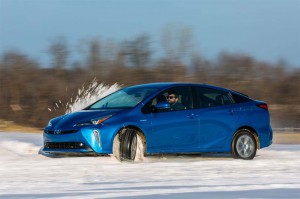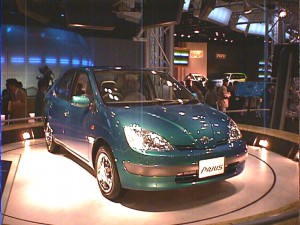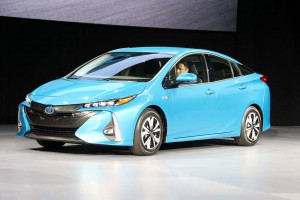Say the word, “hybrid,” and one name is almost certainly going to pop into your mind: Toyota Prius. First launched in Japan in 1997 and brought to the U.S. three years later, it has been the world’s best-selling hybrid-electric vehicle, or HEV, ever since. For several years, earlier this decade, it was the best-selling vehicle in the huge California market and number one in Japan, as well.
But, as the cliché goes, times have changed. Whether due to increased competition, cheap gasoline, or other issues, sales of the original Prius hatchback have been tumbling. Though still the best-selling hybrid in the U.S., the first 11 months of this year saw demand dip 23.2%. And, at just 3,180 vehicles in November, sales are now running barely a quarter of their peak pace earlier in the decade.
Toyota is trying to address some of the issues that came up with the launch of the fourth-generation Prius hatchback for the 2016 model-year, among other things tweaking its design and introducing a new electric all-wheel-drive system that could enhance the car’s appeal in Snowbelt regions. But during a series of interviews at a media drive of the 2019 Prius, Toyota officials acknowledged they are looking at even more radical options for the fifth-generation hybrid hatchback due out early in the coming decade.
(Toyota set to reveal reborn Supra at next month’s Detroit Auto Show. Click Here for more on what’s coming to the show.)
Prius has developed a reputation for being fuel-efficient, reasonably prices and spacious, said Rick Lofasso, Toyota’s U.S. general manager for vehicle marketing. “For 2019, we want to add another descriptor: versatile,” with the addition of AWDe technology.
The system adds a third motor on the Prius hatchback’s rear axle which automatically comes on at speeds up to 6 mph and can continue to assist in low-traction situations until 43 mph.
Toyota is betting that as much as 25% of the Prius hatchbacks that will be sold in 2019 will feature the AWDe system available on several trim levels for an additional $1,400. What remains to be seen is whether it will bring in incremental buyers or simple be ordered by customers who would have bought a Prius anyway.
Even if the AWDe system largely attracts new buyers, Prius is selling at a fraction of its peak rate earlier in the decade, acknowledged Lofasso and other Toyota officials, with little likelihood it will reach former peaks anytime soon – if ever again.
Industry analysts point to a variety of factors for the hybrid hatchback’s decline, including the quirky and controversial design of the latest-generation Prius. But there’s also a lot more competition in a space the hybrid once owned almost entirely – including hybrid versions of the Toyota Corolla sedan and the brand’s best-selling model, the RAV4 crossover. Some observers are betting the RAV4 Hybrid could, in fact, become Toyota’s best-selling HEV within a year or two.
(Toyota has no plans to abandon U.S. car market, says top exec. Click Here for the story.)
There are other factors at play, including cheap gas, as well as the rapid increase in availability of more advanced plug-in hybrids and pure battery-electric vehicles. Toyota itself plans to launch new BEV models when it opens a new plant in Alabama in about two years.
“For the next Prius we have to think about how to…separate (it) from the rest of the Toyota line-up,” said Deputy Chief Engineer Koichi Kaneko, during an interview.
(EV sales skyrocketing in CA. Click Here for the story.)
The Prius executive stressed that while Toyota has added a plug-in hybrid version of the hatchback, dubbed Prime, he does not want to see Prius evolve into either a BEV or a fuel-cell vehicle. Part of that is because of the additional cost that would make it difficult to pitch Prius as “affordable.” There is also the fact that the hatchback and other members of the Prius “family” have long been marketed as “no sacrifice” vehicles. You don’t need to find a charger or a hydrogen pump to get fuel economy that, with the current hatchback pushes beyond 50 mpg.
Nonetheless, Kaneko conceded, “Toyota has to be ready to respond to these trends” reshaping the automotive market and might even have to consider the possibility of either shifting to a crossover body style or adding a CUV to the broader Prius family that today also includes the small Prius C and bigger Prius V.
“I don’t think Prius can be the same as before,” said Kaneko, looking forward to the gen-5 model that is just now beginning to enter the development process. “Our role is to figure out what we can do with it. We need to find a new direction.”
Considering the self-imposed constraints on what a Prius can and must be, the job isn’t going to be easy. But while Prius may not be the brand’s best-seller it remains a critical part of Toyota’s identity, and that means the automaker will be throwing a lot of resources at the problem in a bid to keep the nameplate relevant.
(Toyota’s U.S. CEO warns more tariffs will hurt U.S. auto sales. Click Here for the story.)




The Prius horizontally-split rear window, darkened at the bottom, is and always will be a hazardous vehicle. It is the main reason I won’t buy one. With no option for a full-size rear window with clear glass, that car is unacceptable. Style over substance.